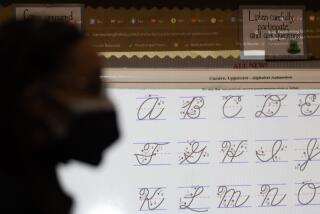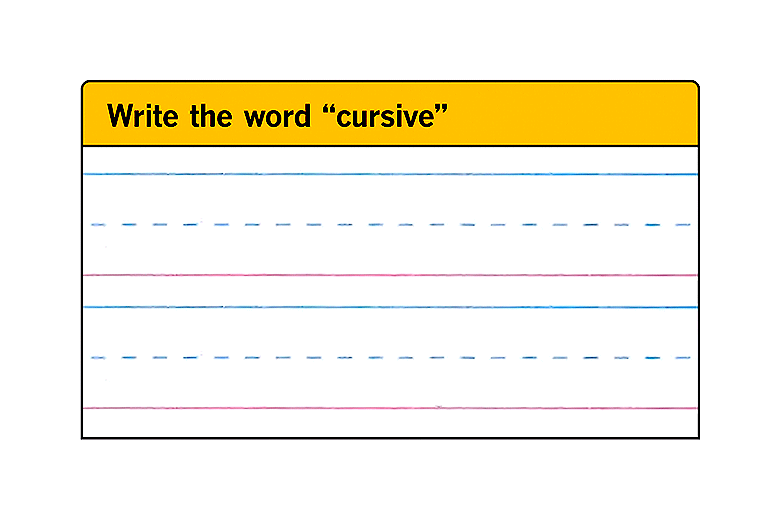Signature Sleuths : Handwriting Experts Increasingly Called to Screen Job Applicants
- Share via
How important is your signature? The next time you apply for a job, you might find that it depends on how you dot your i’s , cross your t’s and loop your l’s and d’s . Handwriting analysis, once tossed in the occult bag of palm reading, tea leaves and crystal balls, is emerging as a screening method used by Orange County employers in hiring.
Carol Booth vividly remembers the day she called in handwriting expert Joyce Lindstrom to review a stack of 20 job applications after a rash of thefts at her wholesale florist business left her casting about for a new method to judge potential employees.
“She pulled out one application and said, ‘I hope you didn’t hire her,’ ” recalls Booth, who runs C. Booth Ltd. in Anaheim. “She said that person’s handwriting showed dishonesty. That was the person who committed the theft. That she could pick out that out of a stack of applications was absolutely amazing.”
Booth now uses handwriting analysis--also known as graphology--to make all her hires. “I go by my personal instinct and also by their qualifications,” Booth says. “But the final say-so is the handwriting. I swear by it.”
Lindstrom, whose Orange consulting firm, Handwriting Reveals, boasts a client list of more than 35 firms including Thomas Temporaries, Illif, Thorn & Company, the Westin South Coast Plaza hotel and Plaza Savings & Loan, says handwriting analysis is gaining acceptability thanks in part to the demise of lie-detector tests. As of last December, employers nationwide were barred by Congress from using lie detectors and other forms of electronic testing in hiring.
The law was prompted by claims that the tests are not accurate. While it prohibits the use of polygraphs, it exempts some government employees and those who work in armed cars and around drugs.
“Companies that would not have used my services before are starting to because they cannot use lie-detector tests anymore,” Lindstrom says. “They need an additional tool to find out more information about the person they are hiring. I can tell them whether the person they’re considering is compatible for the job.”
And employers are finding it more and more difficult to get an accurate read on potential employees because former employers fear litigation if they give negative job references, she said.
Lindstrom acknowledges that handwriting analysis is not foolproof.
“We never tell anyone to make a decision based on the handwriting alone,” she says. “It should be used with other pre-screening measures.”
But if a person changes his or her handwriting to cover up a personality trait such as deceit, she says, the analyst will discover it. “Say somebody takes a handwriting course or reads about it in a book and learns about deceit. If he tries to change a stroke to hide that trait, it will come out in other ways.”
Every person’s handwriting has a skeletal outline that will show up even when trying to change it, Lindstrom says. In addition, analysts use at least five indicators when looking at personality traits.
Lindstrom typically works by asking employers to give her a job description and a list of attributes they are looking for in a candidate. Working with a format approved by her lawyer, she informs job applicants that their handwriting is being reviewed, then asks them to write two standardized paragraphs for testing.
“We can’t predict the future,” she says. “But we can spot strengths and weaknesses.” According to Lindstrom, analysis can determine emotional behavior, mental processes and aptitudes such as whether a person tends to be open-minded, independent, attentive to details, aggressive, responsible, enthusiastic, ambitious, organized or imaginative.
When screening for an accountant position, for example, Lindstrom looks at handwriting that reveals someone who pays attention to detail, who is disciplined and who finishes a job once he or she starts it. “That person’s handwriting might not show him to be the most friendly or warm or outgoing person in the world, but he may be a good accountant,” Lindstrom says.
Jewelry stores and other security-conscious businesses also use handwriting analysis to screen out potentially dishonest applicants, says Lindstrom, whose daughter recently was required to submit her writing for scrutiny before being hired by a Santa Ana jewelry store.
In addition to hiring, Lindstrom uses handwriting analysis to help personnel managers in team-building to match employees who will work well together. She also gives seminars on the topic at conventions, most recently at September’s Southern California Conference on Women at the Anaheim Convention Center. And she has lectured on the use of handwriting analysis in compatibility testing at Parents Without Partners and on its benefits in vocational guidance at several Orange County high schools.
Obviously, a person’s handwriting is as individual as a fingerprint. And no one would argue with the fact that a relaxed person’s handwriting differs greatly from that which is scribbled in a hurry, during times of stress or under the influence of drugs or alcohol. The House of Seagram has long used a public safety advertisement sketching the deterioration of a person’s coordination by showing five identical sentences scrawled at various stages of drinking.
But can handwriting really divine personality traits? That question has intrigued intellectuals through the centuries.
The art of handwriting analysis, or the science as some practitioners argue, dates to Greek philosopher Aristotle who wrote that thought and personality were reflected in handwriting.
In 1622, an Italian scholar made the first attempt at organizing a system of handwriting analysis, and through the years artists and writers, including Charles Dickens, Robert Browning and Edgar Allen Poe, have dabbled in it. It’s even said that English artist Thomas Gainsborough captured the essence of his subjects, and in turn, the lifelike quality of his portraits, by referring to their handwriting samples as he painted them.
Psychologists, too, have been fascinated by handwriting’s correlation to personality. Sigmund Freud, the father of psychoanalysis, wrote, “There is no doubt that men also express their character through their handwriting.” Noted Austrian psychiatrist Alfred Adler called handwriting “frozen gestures, a permanent graph of what’s going on in the mind.” And at the turn of the century, Alfred Binet, best known for his psychological tests of childhood intelligence, studied the use of handwriting analysis in personality testing.
In 1912, Milton Bunker, the father of modern-day handwriting analysis, developed a method of determining which strokes reflect a writer’s personality. Out of his research grew “graphoanalysis,” a branch of graphology that claims to be the only “scientific” method. Students of graphoanalysis receive their training and certification through the International Graphoanalysis Society in Chicago.
According to Joel Holbrock, a spokesman for the 10,000-member organization, graphoanalysis is the only method of handwriting analysis that has been tested for validity and reliability. Graphoanalysts are trained to determine a range of personality traits through individual handwriting strokes and to evaluate the effect of one trait upon another, thus arriving at a total picture of a subject’s personality. And while pre-employment screening ranks as the most popular use of graphoanalysis, Holbrock says, lawyers use it in jury screening and psychologists employ it to gain another angle of insight into a patient’s personality.
Paul Weast, an Anaheim graphoanalyst, who like Lindstrom was trained through the Chicago organization, says experts determine personality traits by studying hundreds of aspects of writing, including: the slant; the zone of individual letters or how high and low the extensions on letters such as g’s and j’s and h’s and k’s fall and rise; the overall size of letters; the spacing of letters within a word; the strokes of individual letters, such as loops on e’s and curves or wedges on the tops of m’s , and the pressure of the handwriting.
For example, the writing’s slant generally determines how emotional a person is, Weast says. “The more the writing slants to the right, the more emotionally responsive a person is, the more they are caught up with their feelings,” he says. “Vertical writers are people with less emotion. They may have deep emotions, but they can’t express them. They hold them in. They’re very objective, very aloof. And when the handwriting starts to bend backward, that simply increases everything we had in the vertical. They pull away from people and look out for themselves. They may be selfish, self-centered.”
Strokes such as the t-bar on the letter t reveal a person’s goals, Weast says. A person who crosses a t smack in the middle of the vertical stroke is practical, while someone who crosses it lower has fewer goals and someone crosses it so high that the two strokes don’t connect tends to be a dreamer, he says. Wide loops on the letter e show broadmindedness, while wide loops on the upper extension of the letter d show imagination.
In general, people whose writing is small tend to be conservative and introverted and the opposite is true of people with larger writing. Interrupted writing with spaces between letters in the same word shows intuitive thinking, while a flowing, connected style reveals logical thinking, Weast says.
Make no mistake, handwriting analysis remains a controversial practice. Critics, particularly forensic document examiners who verify the authenticity of signatures or compare writing for legal cases involving wills, fraud, threatening letters and bills of sale, generally pooh-pooh handwriting analysis.
James Black, an El Toro document examiner, says that unlike his peers, who are trained through law enforcement agencies or through the military, graphologists, including graphoanalysts, are not educated in a science. Black likens the practice to “fortunetelling and palm reading.”
“Their training is in divining personality characteristics rather than in the principles of document examination,” says Black, who works for attorneys and law enforcement agencies throughout Southern California. “The way I put it is that handwriting analysis is not scientifically reproducible. If you took a controlled group of people and analyzed their writing, you wouldn’t find that their personality would be reflected by the handwriting characteristics.”
Such criticism hasn’t stopped employers. Fortune magazine last year featured a New York handwriting expert whose clients included Citibank and Bristol-Myers in its people-to-watch section. And here in Orange County, Lindstrom’s client list keeps growing.
Bob Breskin of Breskin and Mullen, a certified public accounting firm in Orange, swears by handwriting analysis’ usefulness in hiring.
“It helps me in my decision-making and, sometimes, it reassures me of my choice, and, in some cases, eliminates my making a bad choice. I give it quite a bit of weight in the hiring process,” says Breskin.
“The analysis has proven to be right on target with practically everyone I’ve hired. And if you can avoid a mistake in hiring, it not only saves the company money, it also saves the employee a lot of discomfort in being in a job he’s not well-suited for.”
HANDWRITING TRAITS
Strokes that form closed circles, as in a , o , d and g indicate reticence. The writer is not inclined to be talkative.
When circle letters are closed with a loop, the writer tends to be secretive.
A loop to the left of a circle structure offers evidence of self-deceit.
A tick (short, straight stroke) at the beginning of a stroke formation may mean that the writer has a temper.
Short d and t stems indicate independent thinking. The writer is not bound by customs and will act on his own conclusions.
When e’s and small circle letters are compressed, the writer tends toward narrow-mindedness.
Well rounded e’s imply broad-mindedness, or tolerance for the views of others. This is also true of the o , a and g circle formations.
When i- dots appear to the left of the stem, the writer tends to procrastinate.
If the position of the i- dot is to the right of the i- stem, the writer may be impulsive.
Loops above the line indicate abstract imagination in the philosophical, theoretical and religious fields.
The strokes that form the letter t are among the most important of the alphabet structures. This one represents a visionary.
The location of the cross-bar in relation to the height is a measure of the writer’s purpose in life. Practicality is implied here.
A cross-bar bent into a dome-like bow implies a bending of the will. It relates to self-control, and suggests that the writer is trying to overcome a fault.
When the cross-bar resembles a basin, shallowness of purpose is indicated. The writer is not serious or concerned and is not likely to do his best.
Source: International Graphoanalysis Society, Chicago
More to Read
Inside the business of entertainment
The Wide Shot brings you news, analysis and insights on everything from streaming wars to production — and what it all means for the future.
You may occasionally receive promotional content from the Los Angeles Times.










